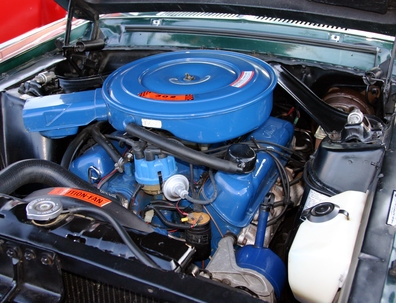
The Pontiac Grand Am 2.4 Liter four-cylinder engine is designed to run in hot and cold weather and stay within a normal range of engine temperatures. Excessive engine temperatures can cause a number of different major engine failures so don't delay finding the source of the overheating problem. The engine cooling system includes the radiator, surge tank, fan, fan motor, thermostat, drive belt and coolant. Always check the coolant while the engine is cold to prevent scalding injuries from hot coolant.
Remove the cap on the coolant surge tank and check the coolant level in the tank. The tank is pressurized so release the cap slowly to release any pressure built up inside.
Add coolant to the FILL line in the surge tank.
Start the engine and let it run until it reaches normal operating temperature and add more coolant, if necessary.
Inspect the serpentine drive belt for tension and wear. Replace the belt if it is cracked or worn and adjust the tension if it is too loose or too tight.
Use your hands to inspect the drive belt for cracks or wear. Run your hands along the whole belt and feel for cracks, missing ribs and sections that have worn smooth.
Replace a defective belt by loosening the tensioner bolt with a wrench until the belt slacks off. Remove the belt and replace it with a new one. Follow the path shown in the diagram on the decal by the radiator.
Rotate the tensioner counterclockwise with a wrench to let the belt fit over it. Release the belt tensioner and it will automatically adjust the belt to the correct tension.
Inspect the radiator core to see if it is blocked by dirt or other materials, or if the fins have been bent and damaged to the point where they cannot transfer heat from the coolant to the outside air.
Clean the radiator fins if they are plugged. Use a pressure washer or hose and soft brush.
Bend damage fins so they are not pressed together or up against the metal pipes in the core. If the fins are too badly damaged the core may require replacement.
Inspect the upper radiator hose by feeling it when the engine is running. Always start with a cool engine. If the engine is running hot but the upper hose does not get hot then the thermostat is likely stuck in the closed position. Replace the thermostat.
Inspect the fan. The fan sits just behind the radiator and helps draw air across the radiator fins. If the blades are broken or damaged replace the fan. The fan is driven by its own motor rather than by the drive belt. A faulty fan motor will cause chronic engine overheating. Testing the motor involves a complex series of steps and special equipment and may require a professional mechanic.
Check the coolant surge tank cap to see if it is holding pressure in the cooling system. This engine does not have a pressure cap on the radiator itself. Listen for hissing at the cap with the engine running. Replace the cap if you can hear air escaping from the cap.